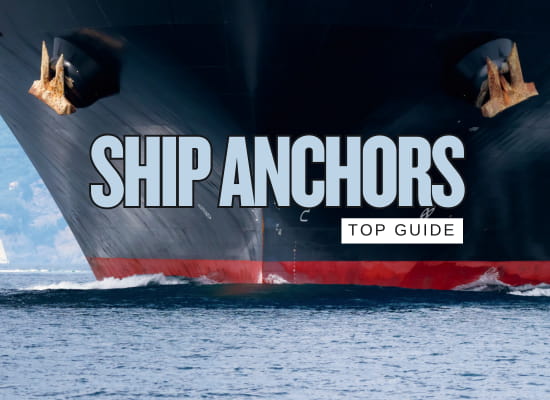Top Ship Anchors: Price and Compare

Anchors aren’t one-size-fits-all. What works for a coastal tanker might not suit a deep-sea bulker or a vessel loading in muddy port conditions. Some anchors bite fast in soft seabeds, others hold firm under heavy strain but need more chain. And not every anchor fits every hawsepipe. This Ship Universe guide breaks down the anchor types most commonly used on commercial ships today — showing where they shine, what to watch for, and how they stack up in the real world.
ShipUniverse: Anchor Selector Tool
| Ship Type: | |
| Anchor Use Location: | |
| Seabed Type: | |
| Class Approval Needed? | |
|
⚓ Select your ship and specs to see matching anchors.
|
|
| Anchor Type Comparison Guide | ||||
|---|---|---|---|---|
| Anchor Type | Holding Power | Best Seabeds | Storage & Fit | Pros & Cons |
| AC-14 HHP Anchor | High holding-to-weight ratio — can meet required holding with less weight, reducing strain on windlass and hull fittings. | Performs best in sand, mud, and clay; penetrates well and holds in soft seabeds. | Compact fluke design allows for easy stowing in most hawsepipes; commonly installed on modern vessels. |
✅ High holding with lower weight ✅ Classification-approved as HHP ❌ More expensive upfront ❌ Can slip in rocky or hard seabeds |
| Spek Anchor | Moderate to high holding depending on size; widely accepted for mid-size commercial ships with modest anchoring needs. | Ideal for firm clay and coarse sand; less reliable in very soft or silty bottoms. | Compact and symmetrical design fits well in smaller hawsepipes or restricted bow spaces. |
✅ Budget-friendly, simple construction ✅ Easy to handle and deploy ❌ Not HHP-rated ❌ Reduced efficiency in soft mud |
| Pool TW Anchor | High holding power, recognized as HHP; good performance in poor seabed conditions while using less chain length. | Performs exceptionally in silt, mud, and clay; favored for anchoring near deltas or silty ports. | Short stock and low profile make it highly stowable; fits snugly in most hawse systems on tankers. |
✅ Excellent soft-ground performance ✅ Great for frequent anchor use ❌ Higher manufacturing cost ❌ Less common outside Europe and Asia |
| Hall Anchor | Moderate holding power; traditional design used reliably for decades, but heavier than newer models for same performance. | Well-suited for coarse sand and gravel; may drag slightly in very soft mud if not sized properly. | Fits standard hawsepipes; still common on older fleets and vessels with basic windlass systems. |
✅ Trusted and familiar to crew ✅ Easy to replace or service ❌ Heavy and inefficient by today’s standards ❌ May underperform in soft bottoms |
| JIS Stockless Anchor | Moderate — solid all-rounder but doesn’t match HHP anchors in extreme conditions. | Versatile across mixed seabeds including sand, clay, and firm silt; not ideal for grass or stone. | Optimized for Japanese-built vessels; well-suited to ships with narrow or shallow hawsepipes. |
✅ Common and easy to source ✅ Performs adequately in most ports ❌ Limited HHP variants available ❌ Lacks advanced grip in soft or rocky ground |
| Delta Anchor | High — popular in offshore and support vessels; excellent re-setting ability and secure embedment. | Thrives in sand and mud; digs deep and holds especially well in layered seabeds or changing currents. | Larger and bulkier; doesn’t always fit standard hawseports without modification or external storage. |
✅ Modern shape and strong holding ✅ Sets quickly after shift or drag ❌ May require custom stowage ❌ Heavier than equivalent fluke anchors |
| Danforth Anchor | High in soft bottoms but inconsistent elsewhere; not typically used as a ship’s primary anchor. | Performs best in fine-grain sand and loose mud; can slip in rocks or kelp beds. | Flat, folding design is great for storage on deck or in lockers; commonly used as a spare or emergency anchor. |
✅ Lightweight and easy to deploy ✅ Great for smaller ships or emergencies ❌ Not suited for frequent anchoring ❌ Prone to shifting in crosswinds |
Our team helps vessel owners like you find the right anchor for your ship — without the pressure. We work with top suppliers to help you compare specs, get the best pricing, and avoid costly mistakes. Whether you’re outfitting a new build or replacing an old anchor, we’re here to make the process easier and faster. Get started with our quick quote request form below.
